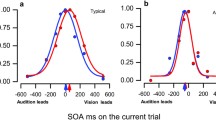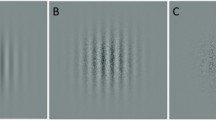Abstract
Signal detection psychophysical experiments were conducted to investigate the visual path of children with autism. Computer generated images with Gaussian noise were used. Simple signals, still and in motion were embedded in the background noise. The computer monitor was linearized to properly display the contrast changes. To our knowledge, this is the first time that experiments of this type have been done with observers with autism. Our results show that the visual capabilities of typically developed children were superior to those of the children with autism, and that the related problems of children with autism are sensation related only in a reduced proportion. There is no evidence that they are disabled in detecting simple visual stimuli, still and in motion.




Similar content being viewed by others
References
Aarons, M., Gittens, T. (1999). The handbook of autism. London: Rutlege.
Bailey, A., Luthert, P., Dean, A., Harding, B., Janota, I., Montgomery, M., Rutter, M., & Lantos P. (1998). A clinicopathological study of autism. Brain, 121, 889–905.
Baron-Cohen, S., Knickmeyer, R. C., & Belmonte M. K. (2005). Sex differences in the brain: Implications for explaining autism. Science, 310, 819–823.
Belmonte, M. K. (2000). Abnormal attention in autism shown by steady-state visual evoked potentials. Autism, 4(3), 269–285.
Belmonte, M. K., & Yurgelun-Todd, D. (2003). Functional anatomy of impaired selective attention and compensatory processing in autism. Cognitive Brain Research, 17(3), 651–664.
Bertone, A., Mottron, L., Jelenic, P., & Faubert, J. (2003). Motion perception in autism: A complex issue. Journal of Cognitive Neuroscience, 15(2), 218–225.
Bevington, P. R. (1969). Data reduction and error analysis for the physical sciences. New York: McGraw Hill.
Blake, R., Turner, L. M., Smoski, M. J., Pozdol, S. L., & Stone, W. L. (2003). Visual recognition of biological motion is impaired in children with autism. Psychological Science, 14, 51–157.
Bogdashina, O. (2003). Sensory perceptual issues in autism and Asperger syndrome different sensory experiences—different perceptual worlds. London: Jessica Kingsley Publishers.
Burgess, A., Wagner, R. F., Jennings, R. J., & Barlow, H. B. (1981). Efficiency of human visual discrimination. Science, 214, 93–94.
Burgess, A. E. & Colborne B. (1988). Visual signal detection. IV. Observer inconsistency. Journal of the Optical Society of America A, 5, 617–627.
Burgess, A. E. (1995). Comparison of receiver operating characteristic and forced choice observer performance measurement method. Medical Physics, 22, 643–655.
Egan, J. P. (1975) Signal detection theory and ROC analysis. New York: Academic Press.
Frith, U. (2003). Autism: Explaining the enigma. Massachusetts: Blackwell Publishing.
Garner, I., & Hamilton, D. (2001). Evidence for central coherence. In J. Richer & S. Coates (Eds.), Autism—the search for coherence (pp. 75–85). London: Jessica Kingsley Publishers.
Gepner, B., & Mestre, D. (2002). Rapid visual-motion integration déficit in autism. Trends in Cognitive Sciences, 6, 455.
Grandin, T. (1992). An inside view of autism. In E. Schopler & G. B. Mesibov (Eds.), High functioning individuals with autism. New York: Plenum Press.
Grandin, T. (2002). My experiences with visual thinking, sensory problems and communication difficulties. http://www.autism.org/temple/visual.html.
Green, D. M., & Swets, J. A. (1966) Signal detection theory and psychophysics. New York: Wiley.
Grelotti, D. J., Gauthier, I., & Schultz, R. T. (2002). Social interest and the development of cortical face specialization: What autism teaches us about face processing. Developmental Pshchobiology, 40, 213–225.
Grice, S. J., Spratling, M. W., Karmiloff-Smith, A., Halit, H., Csibra, G., de Haan, M., & Johnson, M. H. (2001). Disordered visual processing and oscillatory brain activity in autism and Williams syndrome. NeuroReport, 12, 2697–2700.
Hamilton, D., Richdale, A., & Garner, I. (2002). ‘Tunnel vision’ weak central coherence, and susceptibility to visual illusions. Proceedings of the World Autism Congress Melbourne.
Happé, F. G. E. (1996). Studying weak central coherence at low levels: Children with autism do not succumb to visual illusions. A research note. Journal of Child Psychology, 37(7), 873–877.
Irlen, H. (1991). Reading by the colors: Overcoming dyslexia and other reading disabilities through the Irlen method. New York: Avery.
Jolliffe, T., & Baron-Cohen, S. (1997) Are people with autism and Asperger syndrome faster than normal on the embedded figures Test? Journal of Child Psychology and Psychiatry, 38, 527–534.
Judd D. B. (1951). Basic correlates of the visual stimulus. In S. S. Stevens (Ed.), Handbook of experimental psychology (pp. 811–867). New York: John Wiley & Sons.
Macmillan, N. A., Creelman, C. D. (1991). Detection theory: A user’s guide. New York: Cambridge University Press.
Milne, E., Sweettenham, J., Hansen, P., Campbell, R., Jeffries, H., & Plaisted, K. (2002). High motion processing thresholds in children with autism. Journal of Child Psychology and Psychiatry, 43, 255–263.
Minshawi, N. F. (2004). Reliability and concordance of the childhood autism rating scale and DSM-IV in adults with severe and profound mental retardation. Masters thesis, Louisiana State University.
O’Neill, J. L. (1999) Through the eyes of aliens: A book about autistic people. London: Jessica Kingsley Publishers.
Ornitz, E. M. (1989). Autism at the interface between sensory and information processing. In G. Dawson (Ed.), Autism: Nature, diagnosis and treatment (pp. 174–207). New York: Guilford Press.
Pelphrey, K. A., Sasson, N. J., Reznick, J. S., Paul G., Goldman, B. D., & Piven J. (2002). Visual scanning of faces in autism. Journal of Autism and Developmental Diseases, 32(4), 49–261.
Richer, J., & Coates, S. (2001). Autism—the search for coherence. London: Jessica Kingsley Publishers.
Rimland, B. (2000). Cause or coincidence? Autism research review international. 14(4), 1.
Ring, H. A., Baron-Cohen, S., Wheelright, S., Williams, S. C., Brammer, M., Andrew, C., & Bullmore, E. T. (1999). Cerebral correlates of preserved cognitive skills in autism: A functional MRI study of embedded figures task performance. Brain, 122, 1305–1315.
Rovamo, J., Virsu, V., & Nasanen, R. (1978). Cortical magnification factor predicts the photopic contrast sensitivity of peripheral vision. Nature, 271, 54–56.
Sanchez-Marin, F. J., Wilson, D. L., Srinivas, Y, & Jabri, K. N. (2001). Quantitative image quality analysis of a non-linear spatio-temporal filter. IEEE Transactions on Image Processing, 10, 288–295.
Silva-Moreno, A. A., & Sánchez-Marín, F. J. (2003a). Comparison of the visual performance of deaf and hearing children and adults in a detection task. Optical Review, 10, 53–57.
Silva-Moreno, A., & Sánchez-Marín, F. J. (2003b). Visual performance of deaf and hearing, children and adults, in the detection of a moving stimulus. Optical Review, 14, 216–220.
Spencer, J., O’Brien, J., Riggs, K., Braddick, O., Atkinson, J., Wattam-Bell, J. (2000). Motion processing in autism: Evidence for adorsal stream deficiency. NeuroReport, 11, 2765–2767.
Takarae, Y., Minshew, N. J., Luna, B., Krisky, C. M., & Sweeney, J. A. (2004). Pursuit eye movement deficits in autism. Brain, 127(12), 2584–2594.
VanDalen, J. G. T. (1995). Autism from within: Looking through the eyes of a mildly afflicted autistic person. Link, 17, 11–16.
Virsu, V., & Rovamo, J. (1979). Visual resolution, contrast sensitivity, and the cortical magnification factor. Experimental Brain Research, 37, 475–494.
Waterhouse, S. (2000). A positive approach to autism. London: Jessica Kingsle Publishers.
Williams, D. (1998). Autism and sensing. London: Jessica Kingsley Publishers.
Acknowledgment
This work was supported by the Consejo de Ciencia y Tecnología of Guanajuato (CONCyTEG), Mexico.
Author information
Authors and Affiliations
Corresponding author
Rights and permissions
About this article
Cite this article
Sanchez-Marin, F.J., Padilla-Medina, J.A. A Psychophysical Test of the Visual Pathway of Children with Autism. J Autism Dev Disord 38, 1270–1277 (2008). https://doi.org/10.1007/s10803-007-0507-9
Received:
Accepted:
Published:
Issue Date:
DOI: https://doi.org/10.1007/s10803-007-0507-9




